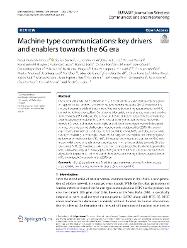| dc.contributor.author | Mahmood, Nurul Huda | |
| dc.contributor.author | Boecker, Stefan | |
| dc.contributor.author | Moerman, Ingrid | |
| dc.contributor.author | Lopez, Onel A. | |
| dc.contributor.author | Munari, Andrea | |
| dc.contributor.author | Mikhaylov, Konstantin | |
| dc.contributor.author | Clazzer, Federico | |
| dc.contributor.author | Bartz, Hannes | |
| dc.contributor.author | Park, Ok-Sun | |
| dc.contributor.author | Mercier, Eric | |
| dc.contributor.author | Saidi, Selma | |
| dc.contributor.author | Osorio, Diana Moya | |
| dc.contributor.author | Jantti, Riku | |
| dc.contributor.author | Pragada, Ravikumar | |
| dc.contributor.author | Annanpera, Elina | |
| dc.contributor.author | Ma, Yihua | |
| dc.contributor.author | Wietfeld, Christian | |
| dc.contributor.author | Andraud, Martin | |
| dc.contributor.author | Liva, Gianluigi | |
| dc.contributor.author | Chen, Yan | |
| dc.contributor.author | Garro, Eduardo | |
| dc.contributor.author | Burkhardt, Frank | |
| dc.contributor.author | Liu, Chen-Feng | |
| dc.contributor.author | Alves, Hirley | |
| dc.contributor.author | Sadi, Yalçın | |
| dc.contributor.author | Kelanti, Markus | |
| dc.contributor.author | Dore, Jean-Baptiste | |
| dc.contributor.author | Kim, Eunah | |
| dc.contributor.author | Shin, JaeSheung | |
| dc.contributor.author | Park, Gi-Yoon | |
| dc.contributor.author | Kim, Seok-Ki | |
| dc.contributor.author | Yoon, Chanho | |
| dc.contributor.author | Anwar, Khoirul | |
| dc.contributor.author | Seppanen, Pertti | |
| dc.date.accessioned | 2021-07-12T21:20:38Z | |
| dc.date.available | 2021-07-12T21:20:38Z | |
| dc.date.issued | 2021 | |
| dc.identifier.issn | 1687-1472 | en_US |
| dc.identifier.uri | https://hdl.handle.net/20.500.12469/4053 | |
| dc.description.abstract | The recently introduced 5G New Radio is the first wireless standard natively designed to support critical and massive machine type communications (MTC). However, it is already becoming evident that some of the more demanding requirements for MTC cannot be fully supported by 5G networks. Alongside, emerging use cases and applications towards 2030 will give rise to new and more stringent requirements on wireless connectivity in general and MTC in particular. Next generation wireless networks, namely 6G, should therefore be an agile and efficient convergent network designed to meet the diverse and challenging requirements anticipated by 2030. This paper explores the main drivers and requirements of MTC towards 6G, and discusses a wide variety of enabling technologies. More specifically, we first explore the emerging key performance indicators for MTC in 6G. Thereafter, we present a vision for an MTC-optimized holistic end-to-end network architecture. Finally, key enablers towards (1) ultra-low power MTC, (2) massively scalable global connectivity, (3) critical and dependable MTC, and (4) security and privacy preserving schemes for MTC are detailed. Our main objective is to present a set of research directions considering different aspects for an MTC-optimized 6G network in the 2030-era. | en_US |
| dc.language.iso | eng | en_US |
| dc.publisher | SPRINGER | en_US |
| dc.rights | info:eu-repo/semantics/openAccess | en_US |
| dc.subject | 6G | en_US |
| dc.subject | E2E performence | en_US |
| dc.subject | Machine type communications | en_US |
| dc.subject | Random access | en_US |
| dc.subject | Ultra reliable low-latency communications | en_US |
| dc.subject | Zero-energy MTC | en_US |
| dc.title | Machine type communications: key drivers and enablers towards the 6G era | en_US |
| dc.type | review | en_US |
| dc.relation.journal | EURASIP JOURNAL ON WIRELESS COMMUNICATIONS AND NETWORKING | en_US |
| dc.identifier.issue | 1 | en_US |
| dc.identifier.wos | WOS:000663497200001 | en_US |
| dc.identifier.doi | 10.1186/s13638-021-02010-5 | en_US |
| dc.identifier.scopus | 2-s2.0-85107897362 | en_US |
| dc.institutionauthor | Sadi, Yalçın | en_US |
| dc.relation.publicationcategory | Diğer | en_US |
















